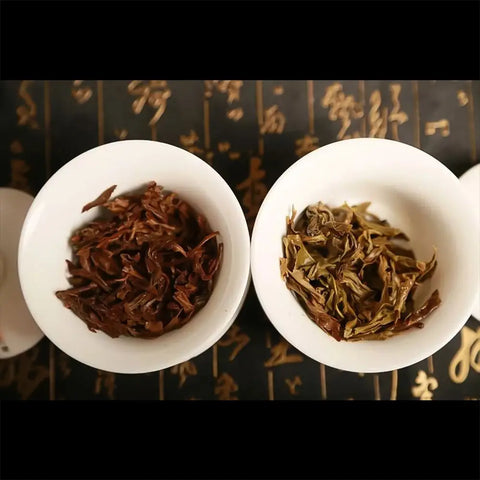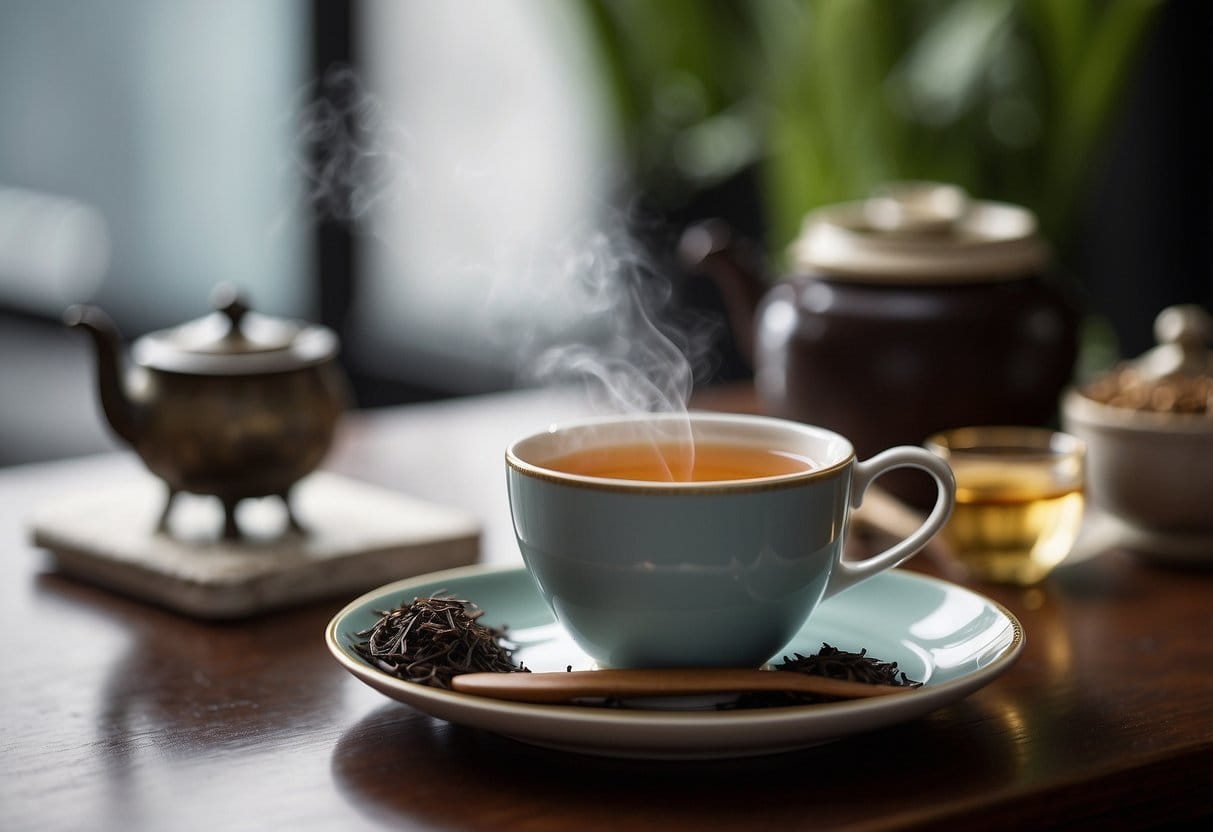What Does Pu Erh Tea Taste Like
Shop our Pu Erh Tea collections!
Pu-erh tea is unique in its aging process and comes from the Yunnan Province of China. It is known for its distinct taste and health benefits.
Definition and Origin
Pu-erh tea is a variety of fermented tea produced in Yunnan Province, China. Named after the city of Pu-erh, this tea ages like wine, improving in flavor over time.
Bestsellers
There are two main types: Sheng (raw) and Shou (ripe). Sheng undergoes natural fermentation and can age for decades. Shou, on the other hand, involves an accelerated fermentation process.
The tea is often compressed into cakes, bricks, or loosely packed. The long history of Pu-erh tea adds to its cultural significance. Known for its complex flavor profile, it has been cherished for centuries.
Processing and Types
The processing of Pu-erh tea is distinct. For Sheng Pu-erh, the leaves are harvested, wilted, and then dried in the sun. They are then either compressed or left loose to age naturally. This process can take many years, allowing the tea to develop its unique taste.
Shou Pu-erh is made by piling the leaves in humid conditions to accelerate fermentation. This process takes a few months compared to natural aging. The fermentation gives Shou Pu-erh a darker color and a more mellow flavor.
Discover our best-selling raw Pu Erh tea and elevate your tea experience today!
Both types of Pu-erh are rich in probiotics, which contribute to their health benefits. The choice between Sheng and Shou depends on your taste preference and patience for aging.
Characteristic Flavor Profile

Pu erh tea is known for its unique and complex flavor. The tea's taste evolves significantly with aging, providing a rich experience.
Earthy and Mellow Notes
Pu erh tea's initial flavor is characterized by earthy and mellow notes. You may notice a distinct aroma reminiscent of damp forest floors. The tea has a deep, full-bodied taste that feels robust and grounding. It often includes hints of wood, mushroom, and sometimes a mild sweetness. The smooth texture adds to its mellow profile, making each sip rich and satisfying.
Aging Influence on Taste
Aging plays a crucial role in the development of pu erh tea's flavor. Younger pu erh tends to have stronger, sharper tastes with astringent notes. As it ages, these bold flavors soften and become more complex. Well-aged pu erh exhibits smoother, more refined earthy tones and increased depth. You might encounter nuances such as caramel, dried fruits, and even a savory umami quality.
Each stage of aging introduces a new layer to this tea's profile, reflecting its transformation over time.
Variations by Region

Lao Ban Zhang
Pu erh tea flavor profiles differ significantly depending on the region of production. Factors such as local climate, altitude, and soil contribute to the unique characteristics found in each varietal.
Yunnan Province Varietals
Yunnan Province is the birthplace of Pu erh tea. Its tea leaves come from ancient tea trees, some over a thousand years old. This region's Pu erh is known for its deep, rich flavors with a pronounced earthiness.
You may notice notes of leather, wood, and sometimes a touch of sweetness. The aging process is crucial, often producing complex profiles that evolve over time.
Differences in Terroir
Terroir plays a vital role in the taste of Pu erh tea. Regions with higher altitudes, such as Lincang, produce tea with a brisker taste and a thicker mouthfeel.
In contrast, areas with cooler climates, like Xishuangbanna, yield teas that are more floral and aromatic. Soil composition also affects the tea, with limestone-rich areas adding a subtle minerality to the flavor.
Brewing Techniques
Mastering the brewing techniques for Pu-erh tea involves understanding the nuances of water temperature and steeping time. These factors significantly influence the flavor and aroma.
Impact of Water Temperature
Water temperature plays a crucial role in unlocking the complex flavors of Pu-erh tea. For raw Pu-erh, 195°F (90°C) is optimal, ensuring the preservation of delicate flavors without bitterness. Ripe Pu-erh benefits from hotter water, around 212°F (100°C), which aids in extracting the rich, earthy notes.
Using a thermometer can help you achieve accurate temperatures. Boil water and let it cool to the desired temperature if you don’t have a variable temperature kettle. Overheating or underheating can result in flat or overly harsh flavors.
Steeping Time Considerations
Steeping time varies depending on whether the Pu-erh is raw or ripe. Raw Pu-erh requires shorter steeping times of 2-3 minutes for the initial infusion to avoid excessive bitterness. Subsequent infusions can be slightly longer, typically 10-15 seconds more with each steep.
Ripe Pu-erh, with its thicker leaves, benefits from longer initial steeping of about 3-5 minutes. For a stronger brew, you may extend the time slightly, but be cautious of over-steeping, which can make the tea overly astringent.
Experiment with these times to find the perfect balance tailored to your taste.
Sensory Experience

When drinking Pu-erh tea, you will encounter a complex aroma and a visually distinct liquor.
Aroma Characteristics
Pu-erh tea tends to have a deep, earthy aroma, reminiscent of damp forest floors or rich, fertile soil. Depending on its age and fermentation, it might also carry hints of woody, nutty, or even slightly sweet undertones.
You may also detect notes of leather or dried fruits like dates and plums. Some types can have an almost mossy or mushroom-like scent, adding to its complexity. The aroma is generally robust and layered, providing a sensory depth that invites contemplation.
Visual Description of Liquor
The liquor of Pu-erh tea varies in color from a rich amber to a deep mahogany, often appearing darker with age.
When brewed, the tea typically displays a clear, bright quality despite its deep hue. In younger Pu-erh, you might notice a reddish tint, while more aged varieties can turn nearly black. The visual clarity and color intensity provide cues about its aging process and quality.
Observing these nuances helps you appreciate the tea's history and craftsmanship.
Health and Well-being Attributes

Pu erh tea, known for its unique flavor, is also valued for its health benefits. It has historical significance in traditional medicine and is being explored by modern scientific research.
Traditional Medicinal Uses
Historically, pu erh tea has been treasured in Chinese medicine for its purported digestive benefits. People drank it to help alleviate bloating and stomach discomfort. It was also believed to aid in reducing fatigue and enhancing vitality.
In addition, pu erh tea has been used for its potential to detoxify the body. Monks and scholars consumed it to clear the mind and maintain focus during long periods of study or meditation. The warmth and earthiness of the tea made it a soothing remedy for cold days.
Modern Scientific Research
Recent studies have examined the bioactive compounds in pu erh tea, such as catechins and polyphenols. These compounds are associated with antioxidant properties, potentially reducing oxidative stress in the body. Research suggests that pu erh tea may help in managing cholesterol levels.
Further scientific investigations are looking into its potential role in weight management. Some studies indicate that compounds found in pu erh tea may influence fat metabolism. Research is ongoing to determine its effects on blood sugar regulation and other metabolic benefits.
Modern studies continue to validate and expand upon traditional beliefs, making pu erh tea an interesting subject for health enthusiasts and researchers alike.
← Older post Newer post →











